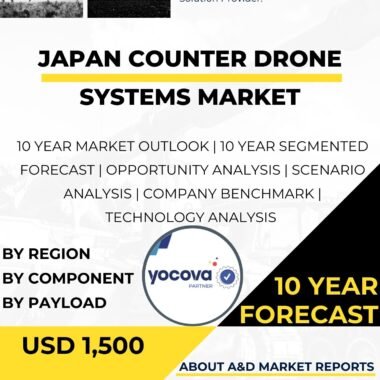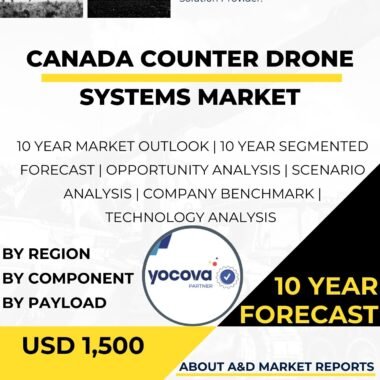Description
The Netherlands Counter Drone Systems market has experienced substantial growth and development in response to the increasing threat posed by drones in both civilian and military contexts. Drones, also known as Unmanned Aerial Vehicles (UAVs), have become widely accessible and affordable, leading to their proliferation in various sectors, including recreational use, commercial applications, and even illicit activities. The Netherlands, being a technologically advanced and densely populated country, recognizes the significance of countering the misuse of drones to protect critical infrastructure, ensure public safety, and safeguard national security.
The rise of drones has brought about numerous opportunities and challenges. While drones offer benefits in areas such as aerial photography, surveillance, and last-mile delivery, they also present potential risks, including unauthorized surveillance, airspace violations, and the potential for malicious use, such as carrying out terrorist attacks or smuggling contraband. As such, the Netherlands has focused on developing and implementing cutting-edge Counter Drone Systems (CDS) to mitigate these risks effectively.
The Dutch government, along with the defense and security industry, has actively invested in research and development to create a comprehensive range of Counter Drone Systems tailored to various scenarios. These systems are designed to detect, identify, track, and neutralize or mitigate drone threats in different environments, including urban areas, critical infrastructure sites, events, and military installations.
The Netherlands Counter Drone Systems market offers a variety of technologies and solutions to address drone threats. One of the primary components of CDS is drone detection systems. These utilize various sensors, such as radar, radio frequency (RF) scanners, and electro-optical/infrared (EO/IR) sensors, to detect and locate drones within the airspace. Advanced CDS can differentiate between drones and other flying objects, such as birds or aircraft, to reduce false alarms and improve accuracy.
Once a drone is detected, the Netherlands’ CDS employ identification and tracking technologies to assess the drone’s intent and behavior. This involves analyzing drone flight patterns, communication signals, and even leveraging artificial intelligence to recognize specific drone models or payloads. Real-time data analysis allows authorities to understand the potential threat level and take appropriate action swiftly.
The neutralization or mitigation of drone threats is a critical aspect of CDS. Non-kinetic solutions include using radio frequency (RF) jammers to disrupt the communication links between the drone and its operator, forcing it to either return to its point of origin or land safely. Similarly, GNSS (Global Navigation Satellite System) jamming can be employed to interfere with a drone’s navigation, rendering it unable to maintain a stable flight.
In more critical scenarios, the Netherlands may utilize kinetic solutions, such as directed energy weapons or net-based systems. Directed energy weapons, like high-powered lasers, can disable drones by burning their electronic components or causing physical damage to the drone’s structure. Net-based systems, on the other hand, can capture a drone in mid-air using a net and bring it to the ground safely.
The Netherlands Counter Drone Systems market also includes countermeasures designed to protect critical infrastructure, such as airports, power plants, and government facilities. Deployable counter drone solutions are used to establish temporary no-fly zones during events or VIP visits. These mobile systems are rapidly deployable and can be adjusted to adapt to specific threat scenarios.
The Netherlands’ approach to countering drone threats also emphasizes collaboration between the government, the defense industry, and other relevant stakeholders. The Dutch government actively engages in partnerships with industry experts, research institutions, and private companies to develop innovative CDS technologies and solutions. These collaborations facilitate knowledge exchange, accelerate technological advancements, and ensure that the Netherlands remains at the forefront of countering emerging drone threats.
The Netherlands Counter Drone Systems market extends beyond its national borders, offering export opportunities for domestically developed CDS technologies. The country’s reputation for technological prowess and commitment to responsible drone use has generated interest from other nations seeking effective counter-drone solutions. Exporting CDS not only boosts the Dutch defense industry but also strengthens international cooperation and contributes to global security efforts.
The Netherlands Counter Drone Systems market is not limited to military and government applications. The private sector, including airports, critical infrastructure owners, and event organizers, also actively invests in CDS to protect their assets and ensure public safety. With the increasing commercial use of drones, businesses seek CDS solutions that can safeguard their operations from potential drone-related disruptions or security breaches.
While the Netherlands Counter Drone Systems market has shown significant progress, it faces challenges that warrant attention. The dynamic and evolving nature of drone technology demands continuous innovation and research to keep pace with the rapidly changing drone threat landscape. The Netherlands must stay vigilant and continuously update its CDS capabilities to counter new and emerging drone threats effectively.
Additionally, ensuring the integration and interoperability of CDS with existing air defense and security systems is critical. A comprehensive and layered defense approach that includes CDS, radar systems, and other air defense assets is essential to create a robust defense against drone threats.
In conclusion, the Netherlands Counter Drone Systems market has witnessed substantial growth and development, driven by the country’s commitment to protecting critical infrastructure, ensuring public safety, and safeguarding national security. The proliferation of drones and their potential misuse in both civilian and military contexts has highlighted the importance of effective counter-drone measures. The Netherlands has actively invested in research, technology development, and collaborations to create a diverse range of CDS solutions that can detect, identify, track, and neutralize drone threats effectively. With a focus on collaboration and export opportunities, the Netherlands is poised to remain a key player in countering drone threats both domestically and on the global stage. As drone technology continues to evolve, the Netherlands’ dedication to advancing its Counter Drone Systems will be vital in maintaining a secure and resilient defense against emerging drone threats.




